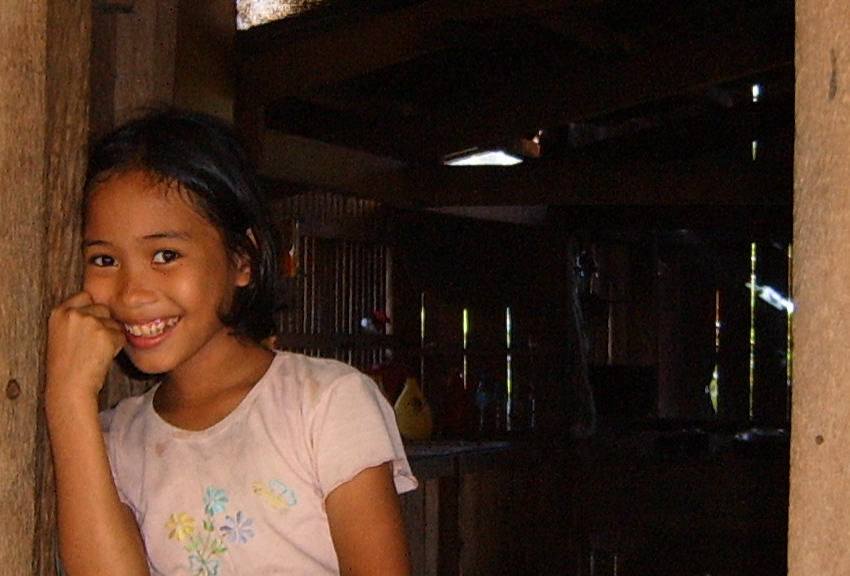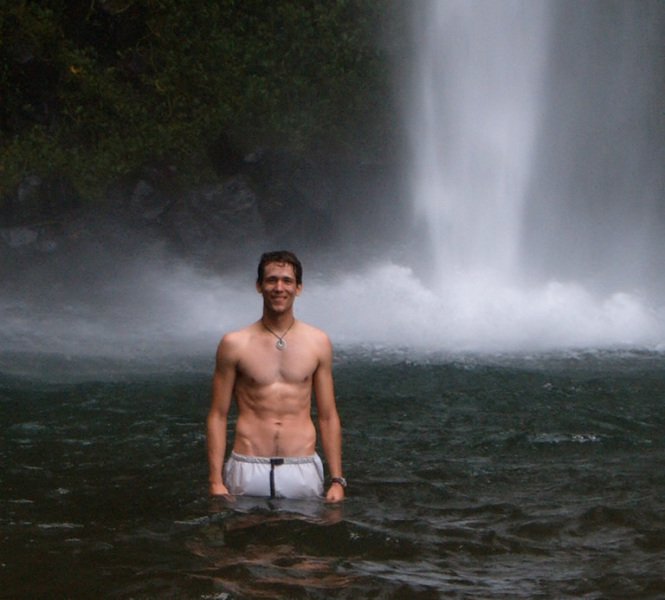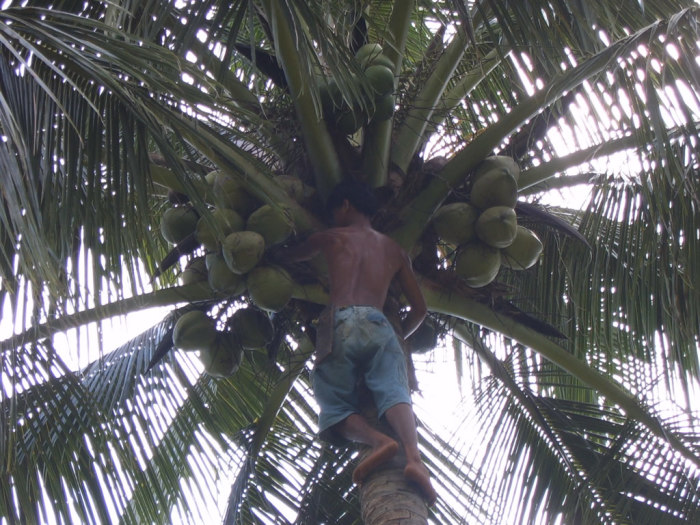Oh what a week it’s been. Now I realize you’re saying “but wait Drew, you haven’t fed the vicarious needs of our boring cubicle lives in TWO weeks!” … and you’d be correct, the point is nothing can compare to what I’ve experienced the last 5 days during our time in San Isidro… which I’ll get to shortly, but first some odds and ends.
So during the first week in the interval some stuff happened, and that ‘some stuff’ can basically be summed up like this:
I talked to people and they:
A) answered my questions without answering them
and/or
B) lied to me
politics and bureaucrats are the same, whether they be in 1st world countries or 3rd.
Other than that, nothing much happened. Melvin and I did find time though to take in one of the main tourist attractions on the island – Katibawasan Falls. The falls are nestled back into a crevice way up on the side of Mt. Hibok-Hibok, 4 kilometers or so from the main island road. Melvin is of the breed that will pay for transportation over the most pathetic of distances so long as he has one last peso in his pocket — I honestly have seen him pay to ride 50yds on the back of a motorcycle…
So to take a stand against this ridiculous sloth, I told him we’d be walking to Katibawasan, all the way up and back. The road looks easy enough when you’re standing at the beginning of it where it intersects the main island road, but once you round the first bend that sumbitch goes UP. Higher, higher, relentlessly higher we trudged on our noonday deathmarch. We marched so high that the *birds* were getting nosebleeds. Finally though, after a solid hour of inclined penance, the road leveled off, the trees grew thick, and the last of the settlements disappeared behind us — we had reached the jungle.
Life is funny, one day you’re young and carefree, and the next *bam* you’re married, 2 kids, a minivan, and doing 40hrs a week at some corporate office. You check your calendar and can count on 2 hands your measly vacation day allotment and you think back, back to those carefree days when you could have gone anywhere but you didn’t. The couch in front of the TV was perfectly good enough. Well for those of you out there who find yourselves hopelessly pinned down under such responsibilities, I offer you the following picture of the true Philippine Jungle. Hold tight to your Dilbert coffee mugs, this one’s a doozy: Melvin is standing on the last stretch of road to the falls, and behind him is unmolested tropical jungle.
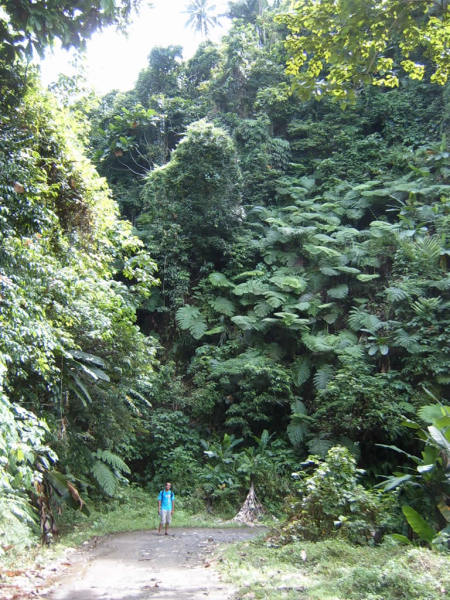
Soon thereafter we reached Katibawasan Falls itself. I’ve always wondered at that naming convention. Katibawasan Falls is a waterfall, -fall, note the singular. When you go there and see it, it is indeed one ribbon of falling water, thus comprising a waterfaLL. And yet when named, it becomes Katibawasan Fall-S. Odd I think.
In any case, visitors walk down a short masonry staircase to the pool at the foot of the falls and if they choose to incline their necks at a dangerously steep angle, this is what they see.
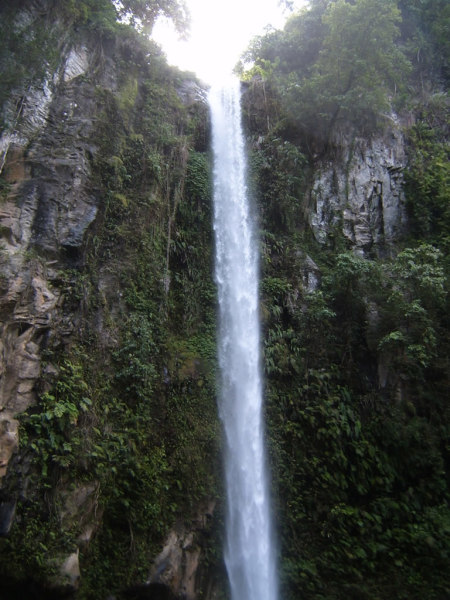
For Melvin and I, having just finished our 60min march of hell halfway up this cursed volcano, the sight of that beautiful icy pool was pure nirvana – and not the Seattle grunge variety.
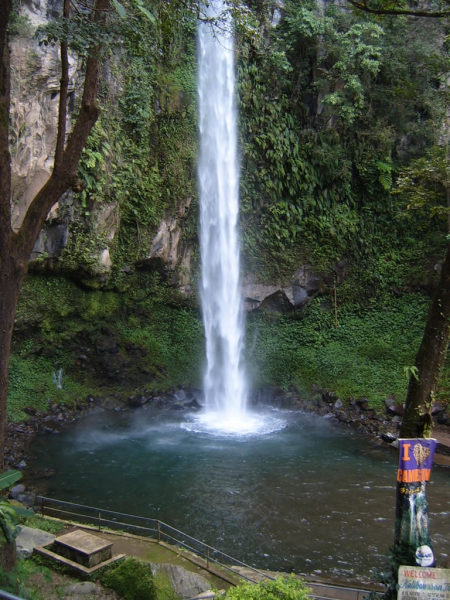
Alas, with any mention of visiting a water attraction, I’d imagine you’ve come to expect the obligatory shirtless author picture, forgive me.
Various signs, both at the fall(s) and around Camiguin, proclaim the wondrous drop to be in the range of 250ft. Upon seeing it with our own four eyes however, Melvin and I are of the opinion that it is probably more like 150ft, which is a figure we found in a national recreation guide — published outside the reach of the Camiguin tourism bureau apparently.
Ok what’s next… well, on another afternoon before we left YumBing for San Isidro I went for a ride on my totally sweet bike and snapped 2 pictures of the island road in a more lightly populated area. The first picture is of a section of road that basically fell into the ocean, along with half the mountain above it, during a landslide event last summer. They’ve shored up the cliff below the road but haven’t yet secured the cliff above the road, so it remains unpaved and dangerous.
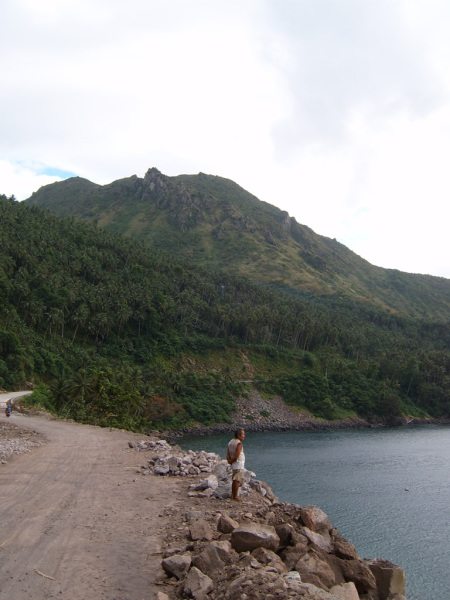
The old fellow in the picture is standing on the edge of a sheer 100m drop straight into the ocean, and tee-hee, so am I. Another 2km or so down the road I had reached the top of a small volcano and was able to look back for this picture of the very area where I was previously standing.
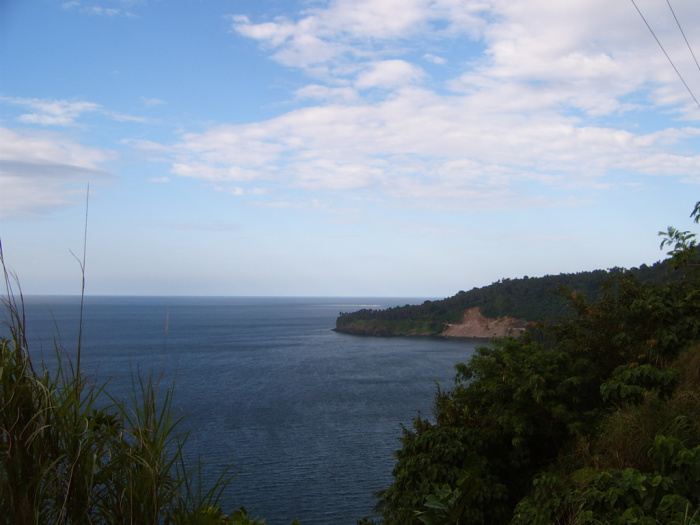
In the background you can see a white sliver in the water — that’s White Island. I took that picture teetering on the edge of yet another cliff, although this one was so much higher that I won’t even bother telling you how high — it’d only serve to keep you up at night.
Shall we go to San Isidro?
San Isidro was / is the main event, the big enchilada, the place yah wanna be — and if you’re gonna be rockin’ it in San Isidro like a real pro, you need to befriend not just any yokel local who happens to walk past leading a cow by the nostrils. No, my friend, you need to kick it with the best of the best, a real man, someone so cool and awesome that he’s the 2nd coolest and awesomest person in the whole world, my very own father being the first of course…
Ladies and Gentlemen, I present you, JORGE GALUA.
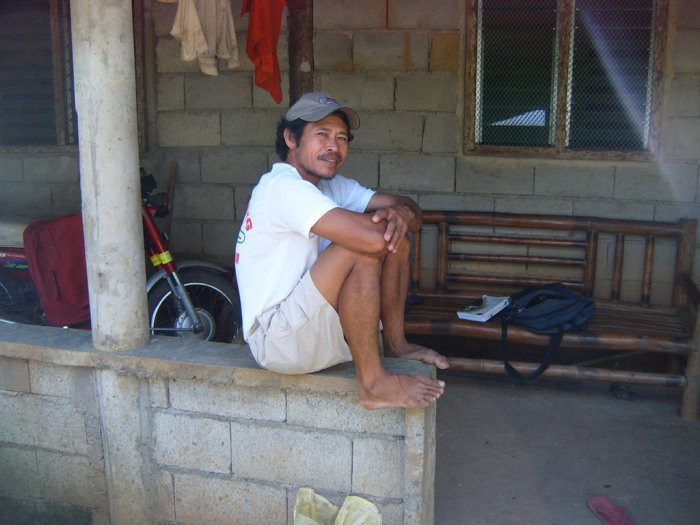
Be not misled by his small stature, he may only come up to my shoulder, but he is a man among ants. Jorge is the head of NAGKAPUNDOK, the community organization who were the participants in the CBFM project I am studying. Jorge is the perennially re-elected head of the organization, as well as just a really cool guy who everyone in San Isidro loves. During the course of the week Melvin and I stayed in a rented spare room at the Galua’s house, and during the days he would lead Melvin and I from participant’s house to participant’s house, and while Melvin surveyed he would teach me as much as I could handle about the San Isidro way of life. It is not a stretch to say that in 5 day’s time I have learned more about coconut farming than most coconuts will ever know.
San Isidro is a wonderful little village of about 100 households perched on some steep-ass slopes about 1km up into the mountains(elevation) and 4km from the main island road. All the residents are subsistence-farmers who sell what little they don’t consume to the markets in the larger towns on Camiguin. Jorge and his wife Karina have 4 children, the two eldest of which are now in college on the mainland, while his two younger children, a boy and a girl, are currently in middle school. Jorge is one of the wealthiest residents of San Isidro, making about $3,500 a year (not a typo) depending on the quality of his harvests. He owns several small patches of land in and about the village, as well as a cow and an ox, and works the CBFM site with the rest of the NAGKAPUNDOK members. And he knows everything there is to know about coconuts, some of which I will now share with you.
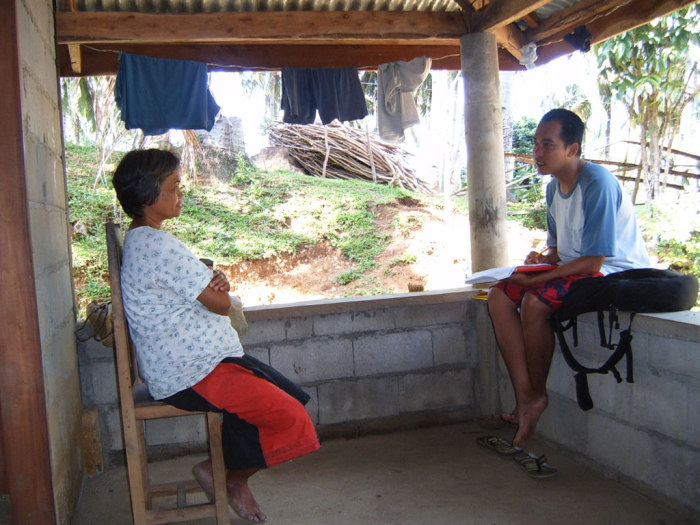
Like I said earlier, while Melvin interviewed survey respondents in their native Visayan dialect, Jorge and I were often discussing the finer points of livelihoods in San Isidro, a great deal of which revolves around coco trees. Coconuts are harvested from the trees 4 times a year by villagers who free-climb the trunks, using only small blazes they have hacked into the bark as foot-rests for support.
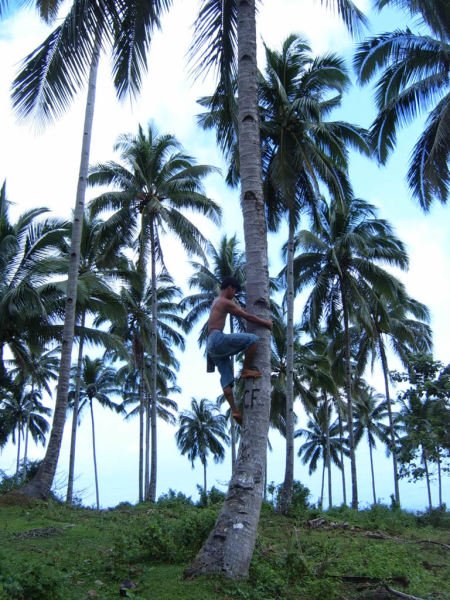
These foot-rests are never more than 2cm wide, and often less. Jorge asked a local teenager who happened to be walking by to demonstrate retrieving a coconut for us.
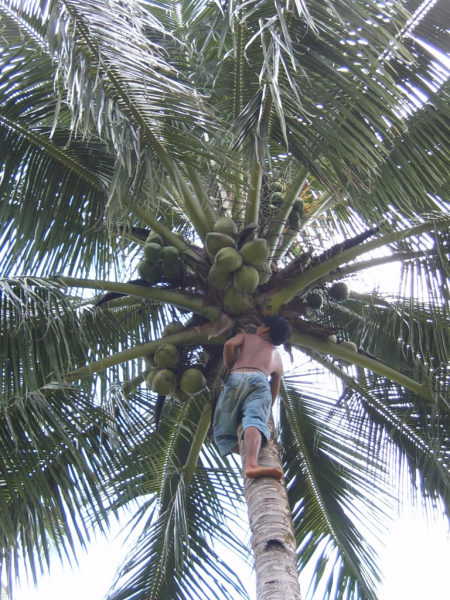
He reached the top of the 80ft tree in less than 10 seconds while I snapped pictures but then realized he needed another step to reach the coconuts, so he grabbed his bolo (machete) and hacked a new one straight away.
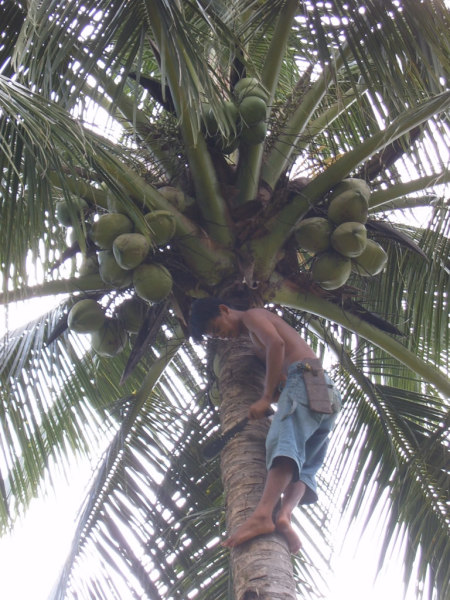
Boys begin free-climbing any and all height coconut trees to harvest the nuts at the age of 7. Once firmly entrenched at the top it was only a matter of reaching in and severing one of the stems connecting a nut to the tree.
Back on terra-most-firma he used his bolo to chop the husk off the nut in no more than 6 firm whacks, the boy had skills.
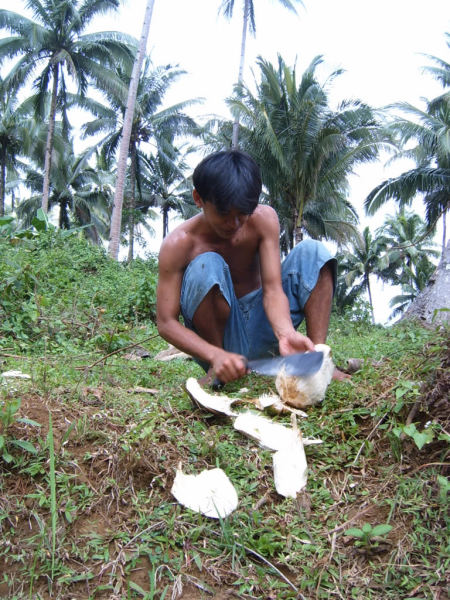
Not content to let the indigenous people have all the fun, and hellbent on getting myself hurt as usual, I decided I too would scale a coco tree using only my God-given hands and feet. Now Jorge, bless his heart, is not familiar with the workings and requirements of a camera, but the two pictures he did manage to take — although blurry and overexposed — are enough to prove that I not only free-climbed a tree…
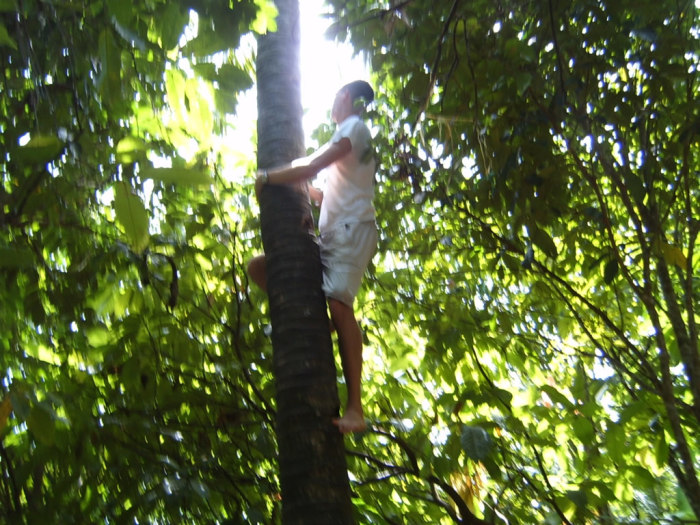
…but made it the 50ft to the very top.
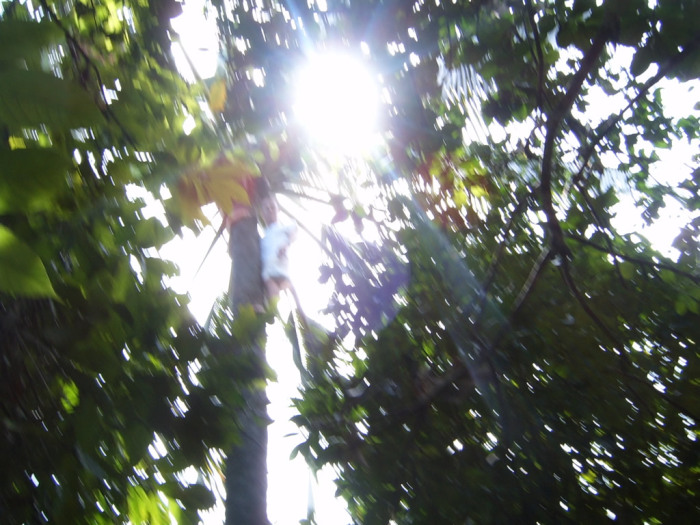
I feel pretty good about that. Melvin on the other hand, when challenged to put his heritage on display, asserted that while he could definitely climb any tree on the island, he just didn’t feel like it. Ok buddy.
Traditionally when harvesting the coconuts the climber actually hoists himself up into the fronds of the tree and perches there as he goes about his business. I was all sorts of game to continue on into the top of my tree but Jorge casually pointed out that I outweigh the fattest San Isidran by at least 40lbs and that the leaves would probably break under my weight. Fair enough Jorge, fair enough. It took me about 2 cautious minutes of careful movements and balance to get up my tree while Jorge was able to literally walk right up it using only one hand for support in less than 10 seconds. He’s in his mid-fifties, so I suppose nearly 50 years of such behavior on a daily basis makes one pretty damn good at it. Later on in the week I had the hilarious pleasure of watching another even older man climb up a very high coco tree near his house while not only carrying on a detailed conversation with four buddies who were drinking at the base, but only using one hand so he could hold and take intermittent drags from his lit cigarette in the other. It doesn’t get much more cavalier than that folks.
Once the coconuts are cut they’re hauled back down to the village in gunny sacks. The first step is removing the husks, which can be done with a bolo as previously demonstrated, but a far quicker and safer way is to impale the husk on a large iron spike (I swear it’s safer!) and then pry the husk off the nut.
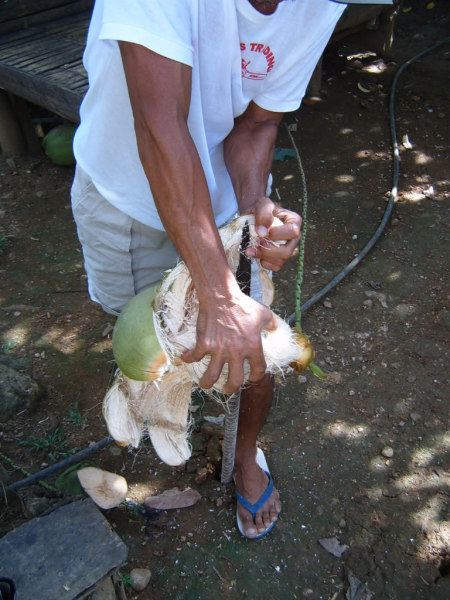
I again was able to successfully attempt the process, but it took about 5 minutes of struggling (to Jorge’s ~20 seconds) and a good deal of mild profanity. If you didn’t notice Jorge’s forearms in the previous picture, look again! The man is as taut as a drum — if I look half that good at 55 I’ll be a happy man. I said I was able to do it though, and I have proof, behold my de-husked coconut, primed and ready for further defilement.
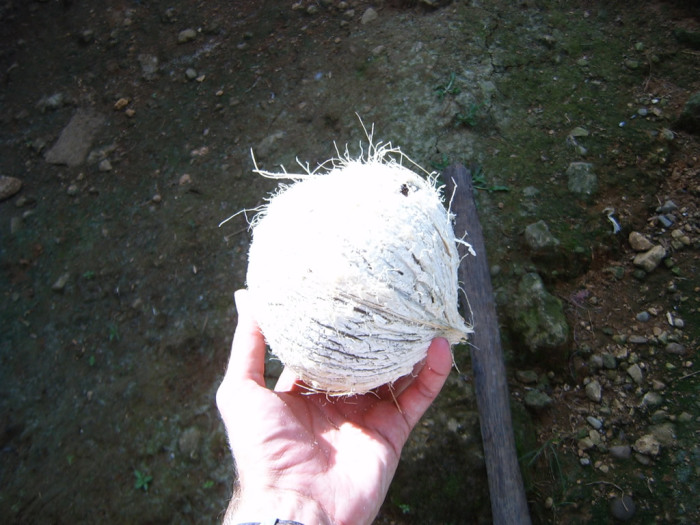
Having husked the coconut you then must crack it. Jorge skillfully showed that two swift whacks on opposite ends with the back of your bolo will crack it into perfect hemispheres.
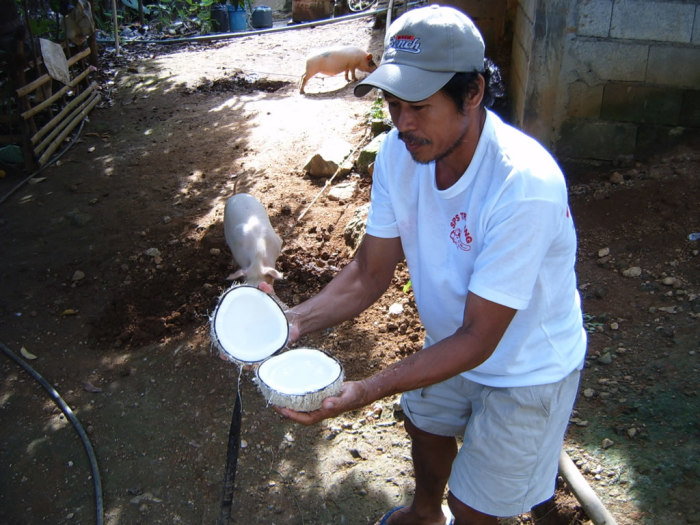
Now things get interesting. The meat can be processed one of two ways – either it can be shredded for general consumption as a food ingredient, or it can be dried in large hunks called “copra” which are then pressed to make coconut oil. If the meat is to be shredded the villager scrapes the coconut half against a metal shank nailed onto the end of a piece of wood which (s)he straddles. The shavings then collect in a large bucket beneath the metal shank. That’s Jorge’s 14 year old son by the way, although I can’t remember his name at the moment, nice kid.
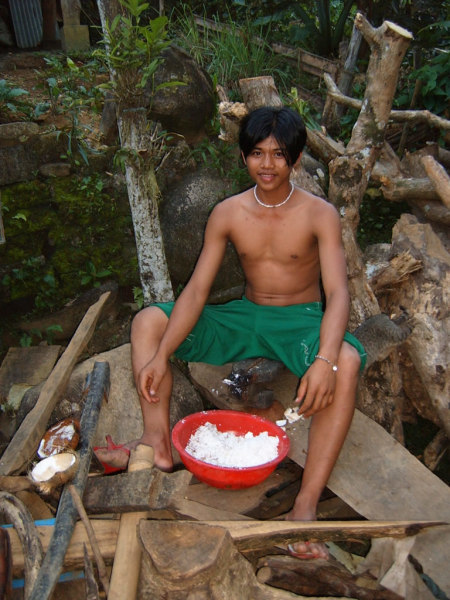
If you’re going to make copra however, the process is different. Since you’re going to send the meat to a mill to be pressed you first want to extract it not in small slivers but in big fat chunks. So you use a special tool that looks like a bent butter knife with a wooden handle. This is driven into the meat like you’re slicing a pie, and then flipped and the flat edge is used to pry the pie-shaped wedges out of the coconut. It’s marvelously simple and easy, and Jorge gave me a big high-five when I managed to completely gut my coconut-half in a very short amount of time.
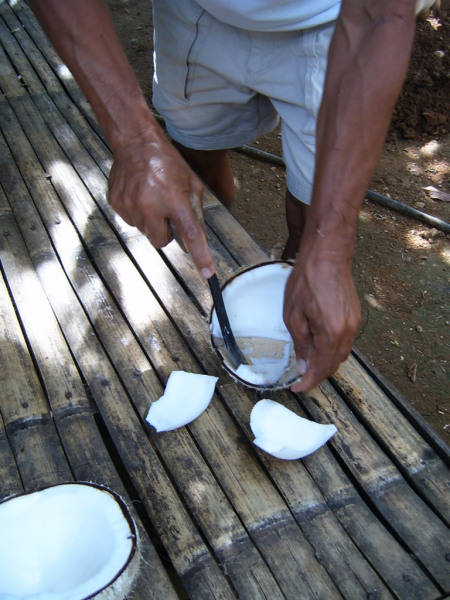
Once you’ve scooped out all your meat, you have to dry it. The most common method is by depositing it in the copra-dryer. This is a small concrete-block structure resembling a furnace.
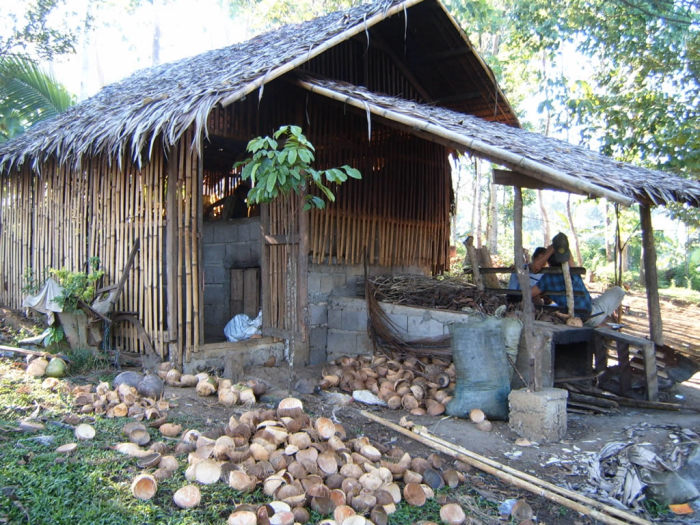
A small fire is built and kept going at the narrow ground-level entrance (to the right in the previous picture), the heat from which travels down the tunnel and up into the piled copra, which is layered nearly 2ft deep atop bamboo slats.
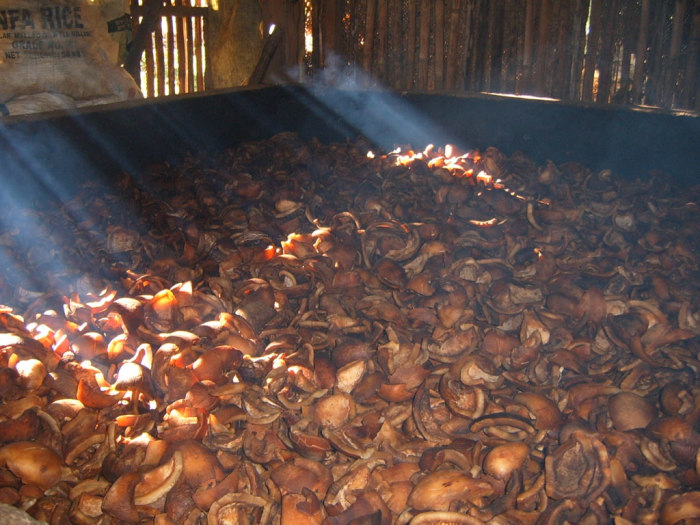
Using this method the copra is fully prepared after just over 24 hours of continuous heating. The outside turns a nice healthy brown quite quickly, but if you squeeze one you can see that the inside is still white, so this batch was not yet done when I took these pictures.
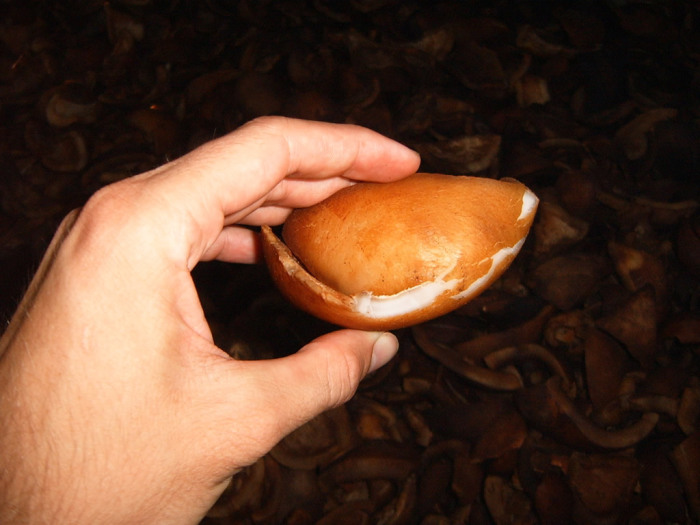
The other method is to dry the meat simply by laying it out under the baking sun, usually spread on the village’s basketball court. This takes 5 or 6 days of continuous sunlight and you run the risk of unsupervised copra being plundered by the wandering village chickens, but the quality is higher and it commands a better price at the oil mills. We’re not through yet though folks, they don’t call this plant the Tree of Life for nothing, they use allllllllllll of it. The nut shells are not discarded, instead they are turned into charcoal by slowburn in a 55 gallon drum.
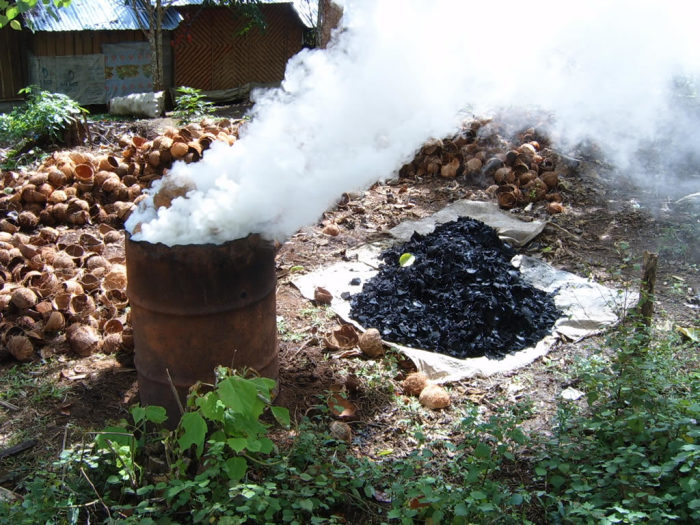
The charcoal is then loaded into sacks ready for delivery to market.
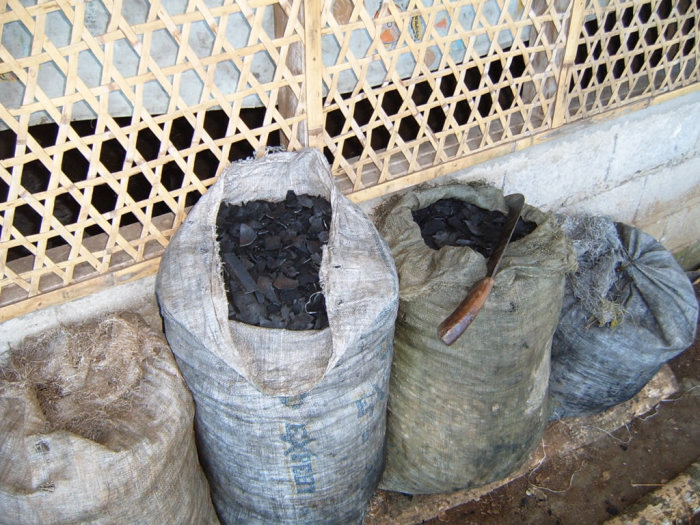
The palm leaves are made into brooms, and when the trees are finally cut down at about 60 years of age, having grown too tall to be safely climbed, they are made into coconut lumber.
*Yawn*
That finally covers it for coconut agriculture, I’ve got a few random tidbits to share and then this post is through.
The surveys have been going well enough. We have to be careful when we interview the men though, because if you can find a male head of a household in the village before dinner time, it means he has probably taken the day off and is therefore usually quite drunk(on sugarcane wine). Now it has been our experience that these drunk fellows give wonderfully honest answers, having diluted their self-consciousness with alcohol, but they are easily distracted and go on long-winded diatribes over the simplest “yes” or “no” question thereby making the survey take two or even three times as long. So in the afternoons at least, we prefer interviewing the female head, although in the interest of alacrity we take what we can get. Also, while we have several demographic questions that record the respondent’s education level, without evening knowing what they tell Melvin I can guess their relative level of educational attainment just by how long the survey takes. A San Isidran who has completed high school can finish the survey in as little as 12 minutes, one who has only attended school through Grade 3 can take as long as 45 minutes. Unfortunately, due to family labor demands I’m discovering that the vast majority of the community hasn’t attended school past Grade 6, although with the younger generation they’re generally finishing high school now. While one could reasonably argue that you don’t need a high school education to know how to climb a coco tree and efficiently wield a bolo, when people have a hard time answering simple “yes” or “no” comparison questions you start to get the feeling that their lives are lacking a certain enrichment that post-elementary education would have otherwise provided, and that’s a shame.
Houses in San Isidro vary a great deal in size, but generally you can’t find anything over 900 sq ft, with the average probably being more like 200 or even 150. Construction is primarily a mix of cinder blocks and concrete, coconut lumber, and woven bamboo — this all varies of course with the wealth of the family, and those items having been listed in descending value.
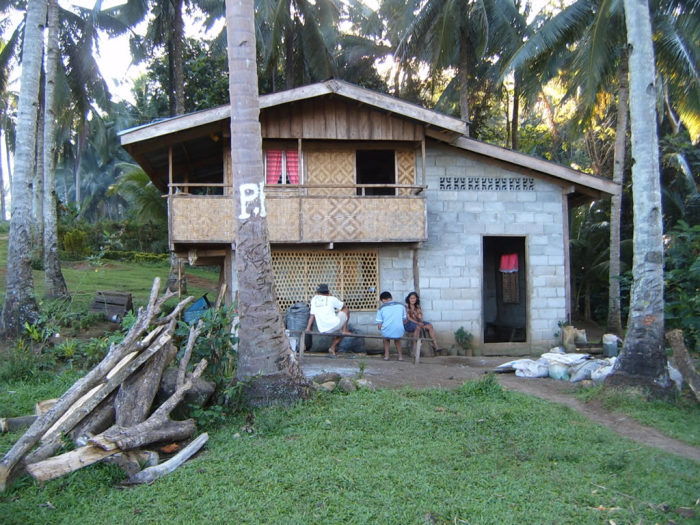
Two-story houses like the one pictured do occur, but they’re rare. From what I’ve found so far, the 2nd story of nearly all two-story houses was added on much later, usually paid for by funds sent home from grown children now living and working on mainland Mindanao or in Manila. I should add that on average a ~800 sq ft house like the one pictured will cost about 50,000P to be built by the village carpenter, which is more or less only $1,000.
During our interviews I am almost always a fascinating spectacle for the household’s children, standing as I do at least a head taller than anyone they’ve ever seen before – not to mention I’m a great deal *whiter* than the deeply tanned residents. Sometimes the children can be extremely friendly, like this beautiful young lady.
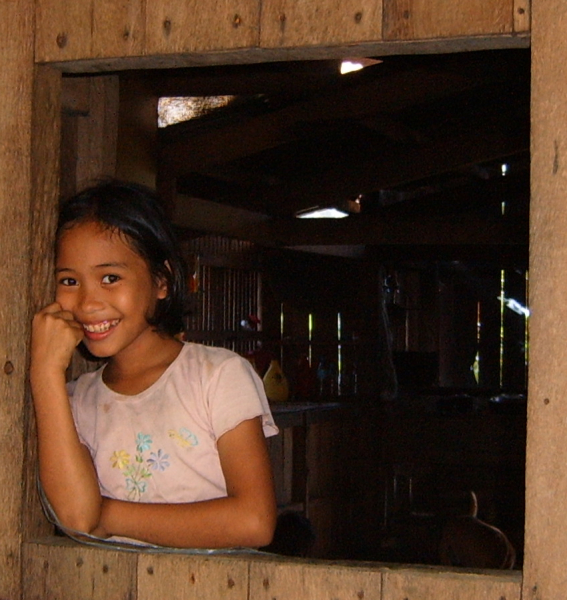
Other times they can be suspicious and stand-offish, but I don’t take it personally, and can usually get them to eventually crack a smile with my awesome variety of silly faces.
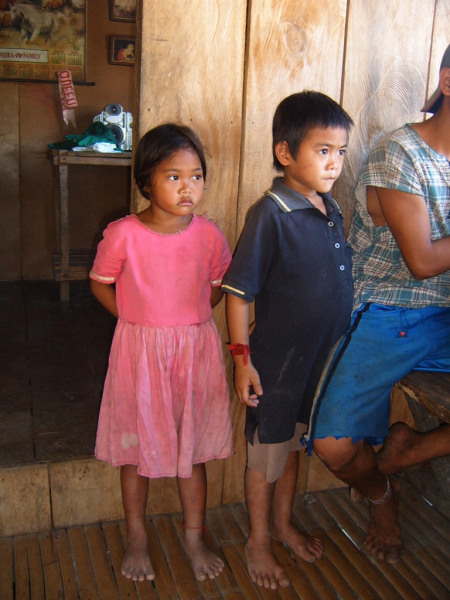
Lastly, no journal post would be complete without an embarrassing picture of my dear friend Melvin. When Melvin turns in to bed before me he has the hilarious habit of leaving all the lights on for me. This is considerate, but somewhat silly considering he has a really difficult time sleeping with any light on at all. The end result of this situation is me coming in to go to sleep only to find all the lights on and him out cold looking as if he has actually managed to suffocate himself.
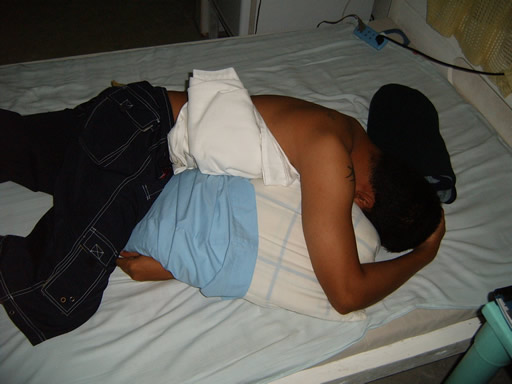
In terms of what lies ahead for me and my research: I have 4 weeks left on Camiguin before I head back to Manila for a week and then on to Japan. I will spend all of next week mapping San Isidro with my GPS while Melvin finishes the surveys. In the final 3 weeks I will visit the regional DENR office to *hopefully* get copies of all the documents the Camiguin local office has told me “they don’t have” — I’ll interview the project coordinator from PRRM who was responsible for daily operations in San Isidro during the 3 year CBFM period and who now lives in CDO — I’ll visit the local Dept of Agriculture to *hopefully* get copies of the agricultural production profile for San Isidro — I’ll visit NAMRIA(similar to our USGS) to *hopefully* get contour maps of the island — and I’ll formally interview DonDon, the Camiguin’s PRRM head, on tape.
That’s all for now, I’m not sure if I’ll be back with a new post on the 11th but I’ll try(if not it’ll be the 18th for sure)– I can already promise you though that the theme for the next update will be “Pirates & Bananas!”
Stay Tuned!
